tire size TOYOTA TACOMA 2020 Warranties & Maintenance Guides (in English)
[x] Cancel search | Manufacturer: TOYOTA, Model Year: 2020, Model line: TACOMA, Model: TOYOTA TACOMA 2020Pages: 260, PDF Size: 8.54 MB
Page 229 of 260
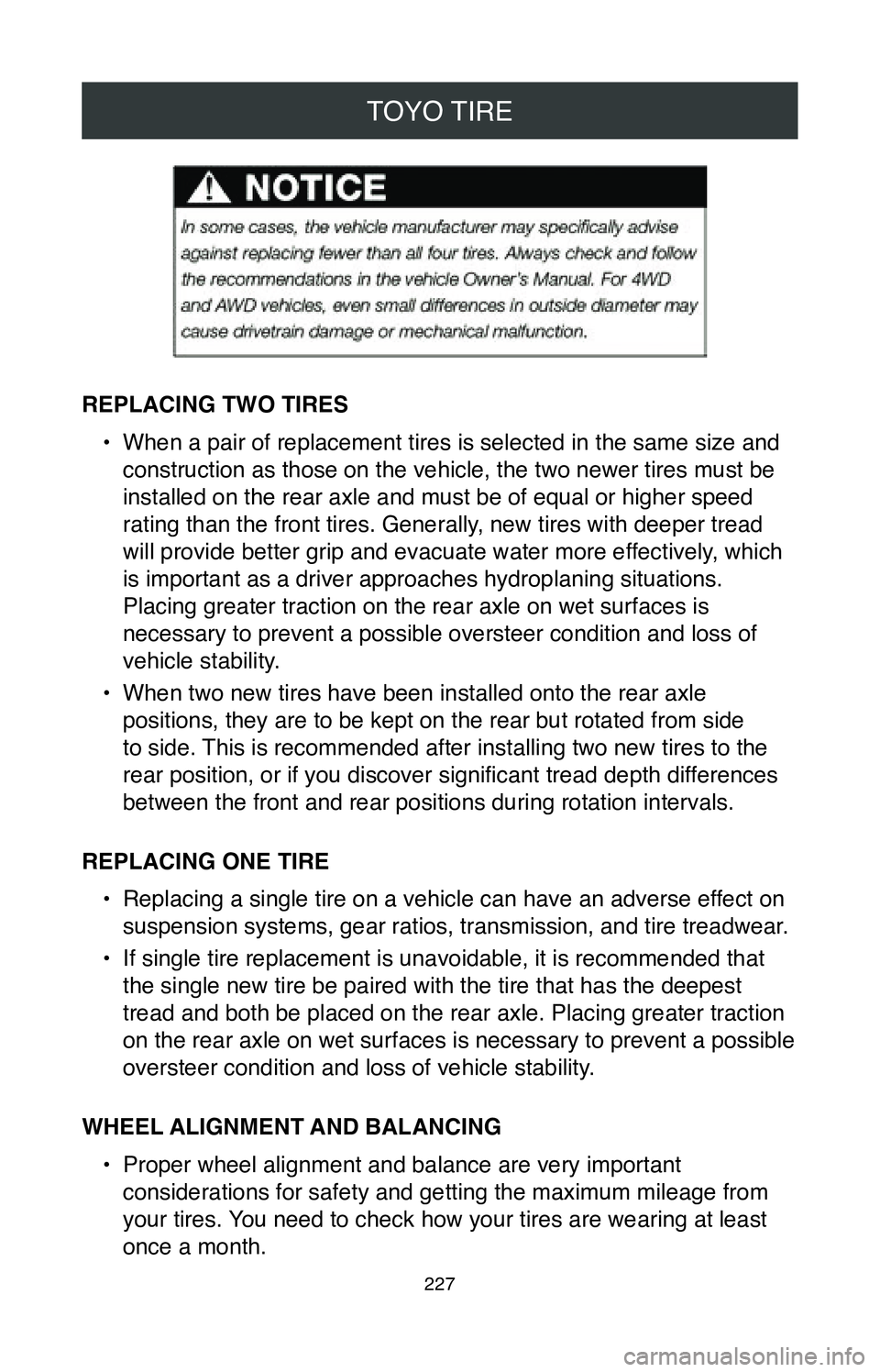
TOYO TIRE
227
REPLACING TWO TIRES•
When a pair of replacement tires is selected in the same size and
construction as those on the vehicle, the two newer tires must be
installed on the rear axle and must be of equal or higher speed
rating than the front tires. Generally, new tires with deeper tread
will provide better grip and evacuate water more effectively, which
is important as a driver approaches hydroplaning situations.
Placing greater traction on the rear axle on wet surfaces is
necessary to prevent a possible oversteer condition and loss of
vehicle stability.
•
When two new tires have been installed onto the rear axle
positions, they are to be kept on the rear but rotated from side
to side. This is recommended after installing two new tires to the
rear position, or if you discover significant tread depth differences
between the front and rear positions during rotation intervals.
REPLACING ONE TIRE •
Replacing a single tire on a vehicle can have an adverse effect on
suspension systems, gear ratios, transmission, and tire treadwear.
•
If single tire replacement is unavoidable, it is recommended that
the single new tire be paired with the tire that has the deepest
tread and both be placed on the rear axle. Placing greater traction
on the rear axle on wet surfaces is necessary to prevent a possible
oversteer condition and loss of vehicle stability.
WHEEL ALIGNMENT AND BALANCING •
Proper wheel alignment and balance are very important
considerations for safety and getting the maximum mileage from
your tires. You need to check how your tires are wearing at least
once a month.
Page 232 of 260
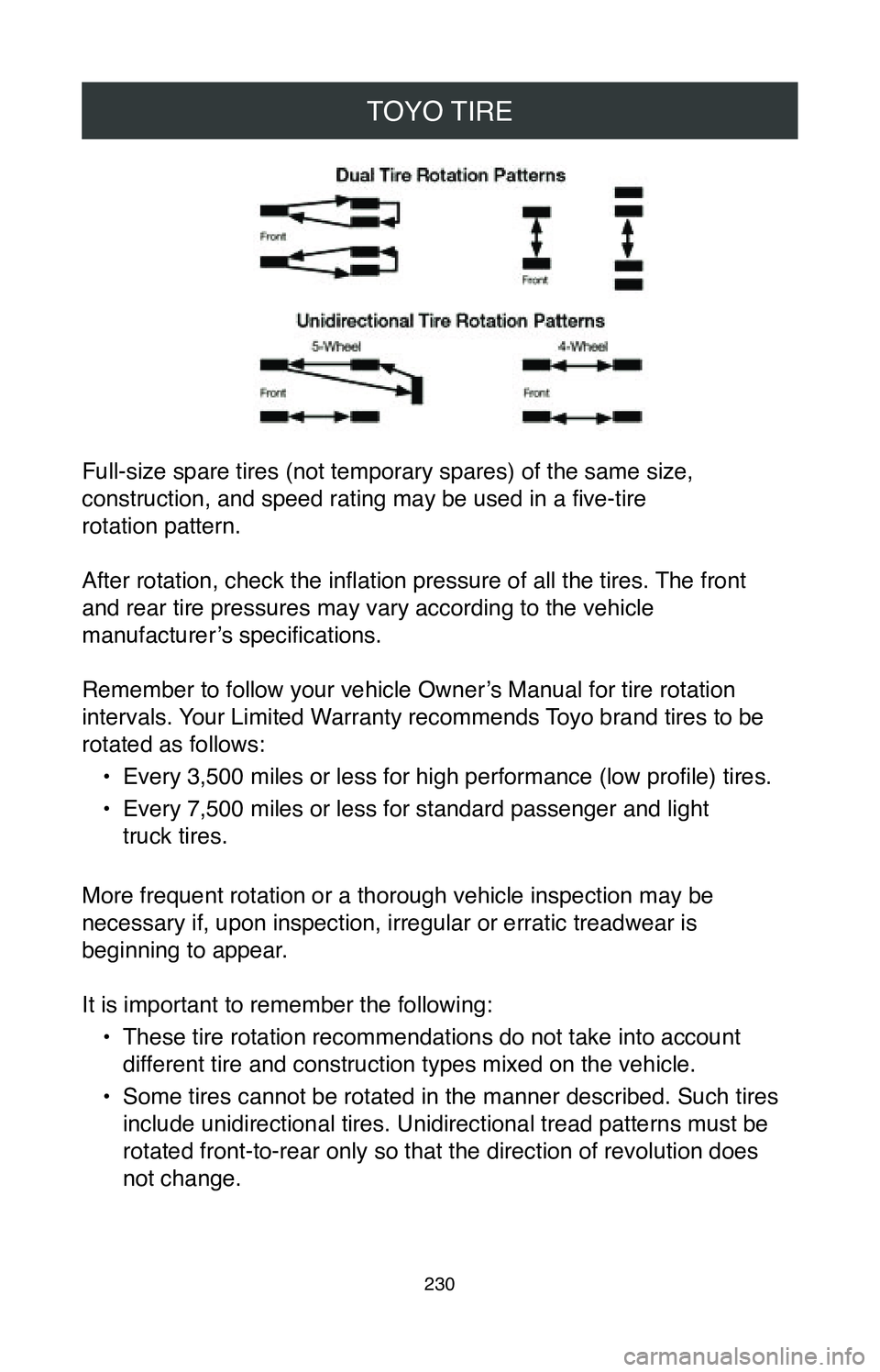
TOYO TIRE
230
Full-size spare tires (not temporary spares) of the same size,
construction, and speed rating may be used in a five-tire
rotation pattern.
After rotation, check the inflation pressure of all the tires. The front
and rear tire pressures may vary according to the vehicle
manufacturer’s specifications.
Remember to follow your vehicle Owner’s Manual for tire rotation
intervals. Your Limited Warranty recommends Toyo brand tires to be
rotated as follows:
•
Every 3,500 miles or less for high performance (low profile) tires.
•
Every 7,500 miles or less for standard passenger and light
truck tires.
More frequent rotation or a thorough vehicle inspection may be
necessary if, upon inspection, irregular or erratic treadwear is
beginning to appear.
It is important to remember the following: •
These tire rotation recommendations do not take into account
different tire and construction types mixed on the vehicle.
•
Some tires cannot be rotated in the manner described. Such tires
include unidirectional tires. Unidirectional tread patterns must be
rotated front-to-rear only so that the direction of revolution does
not change.
Page 233 of 260
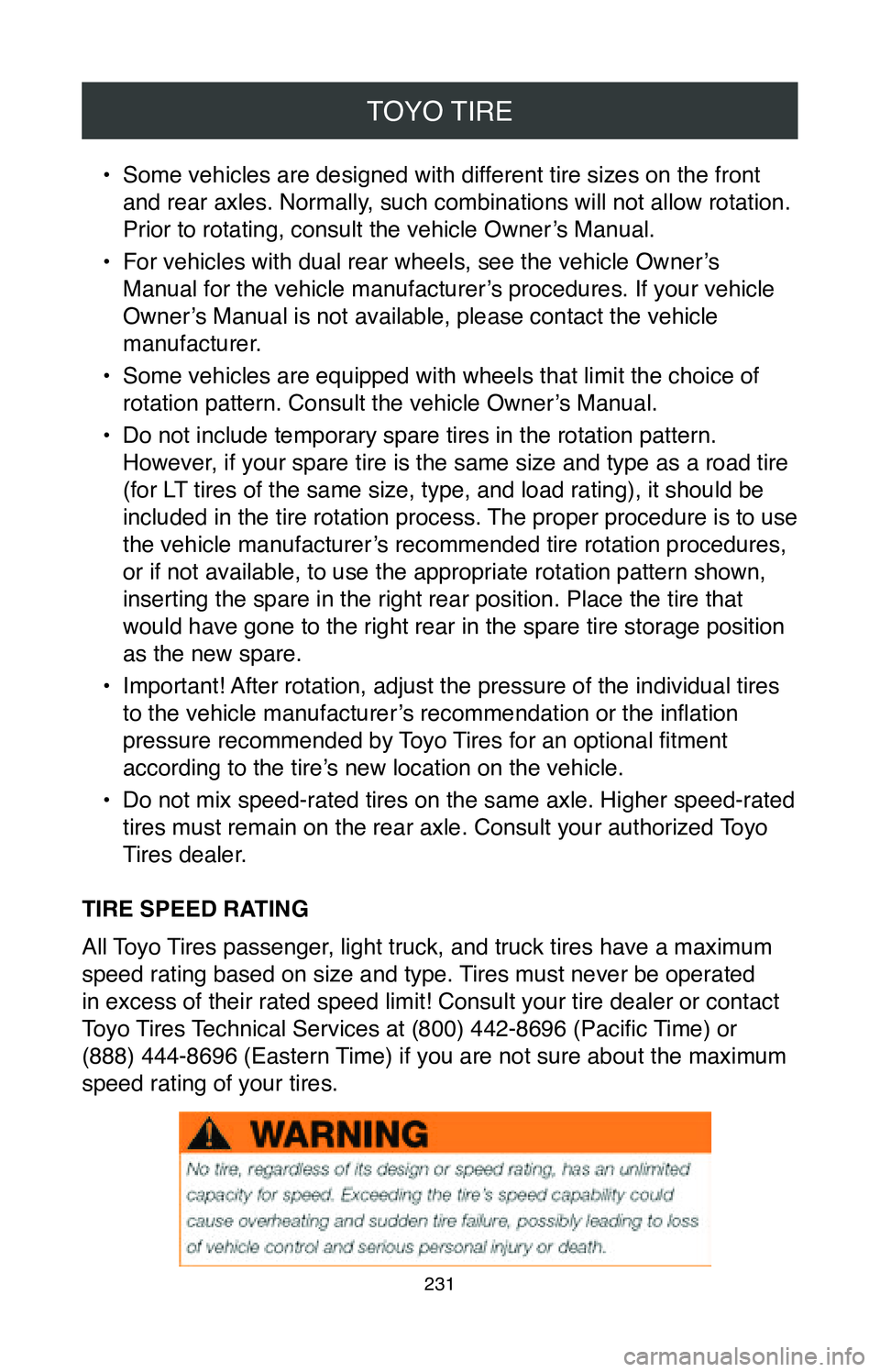
TOYO TIRE
231
• Some vehicles are designed with different tire sizes on the front
and rear axles. Normally, such combinations will not allow rotation.
Prior to rotating, consult the vehicle Owner’s Manual.
•
For vehicles with dual rear wheels, see the vehicle Owner’s
Manual for the vehicle manufacturer’s procedures. If your vehicle
Owner’s Manual is not available, please contact the vehicle
manufacturer.
•
Some vehicles are equipped with wheels that limit the choice of
rotation pattern. Consult the vehicle Owner’s Manual.
•
Do not include temporary spare tires in the rotation pattern.
However, if your spare tire is the same size and type as a road tire
(for LT tires of the same size, type, and load rating), it should be
included in the tire rotation process. The proper procedure is to use
the vehicle manufacturer’s recommended tire rotation procedures,
or if not available, to use the appropriate rotation pattern shown,
inserting the spare in the right rear position. Place the tire that
would have gone to the right rear in the spare tire storage position
as the new spare.
•
Important! After rotation, adjust the pressure of the individual tires
to the vehicle manufacturer’s recommendation or the inflation
pressure recommended by Toyo Tires for an optional fitment
according to the tire’s new location on the vehicle.
•
Do not mix speed-rated tires on the same axle. Higher speed-rated
tires must remain on the rear axle. Consult your authorized Toyo
Tires dealer.
TIRE SPEED RATING
All Toyo Tires passenger, light truck, and truck tires have a maximum
speed rating based on size and type. Tires must never be operated
in excess of their rated speed limit! Consult your tire dealer or contac\
t
Toyo Tires Technical Services at (800) 442-8696 (Pacific Time) or
(888) 444-8696 (Eastern Time) if you are not sure about the maximum
speed rating of your tires.
Page 234 of 260
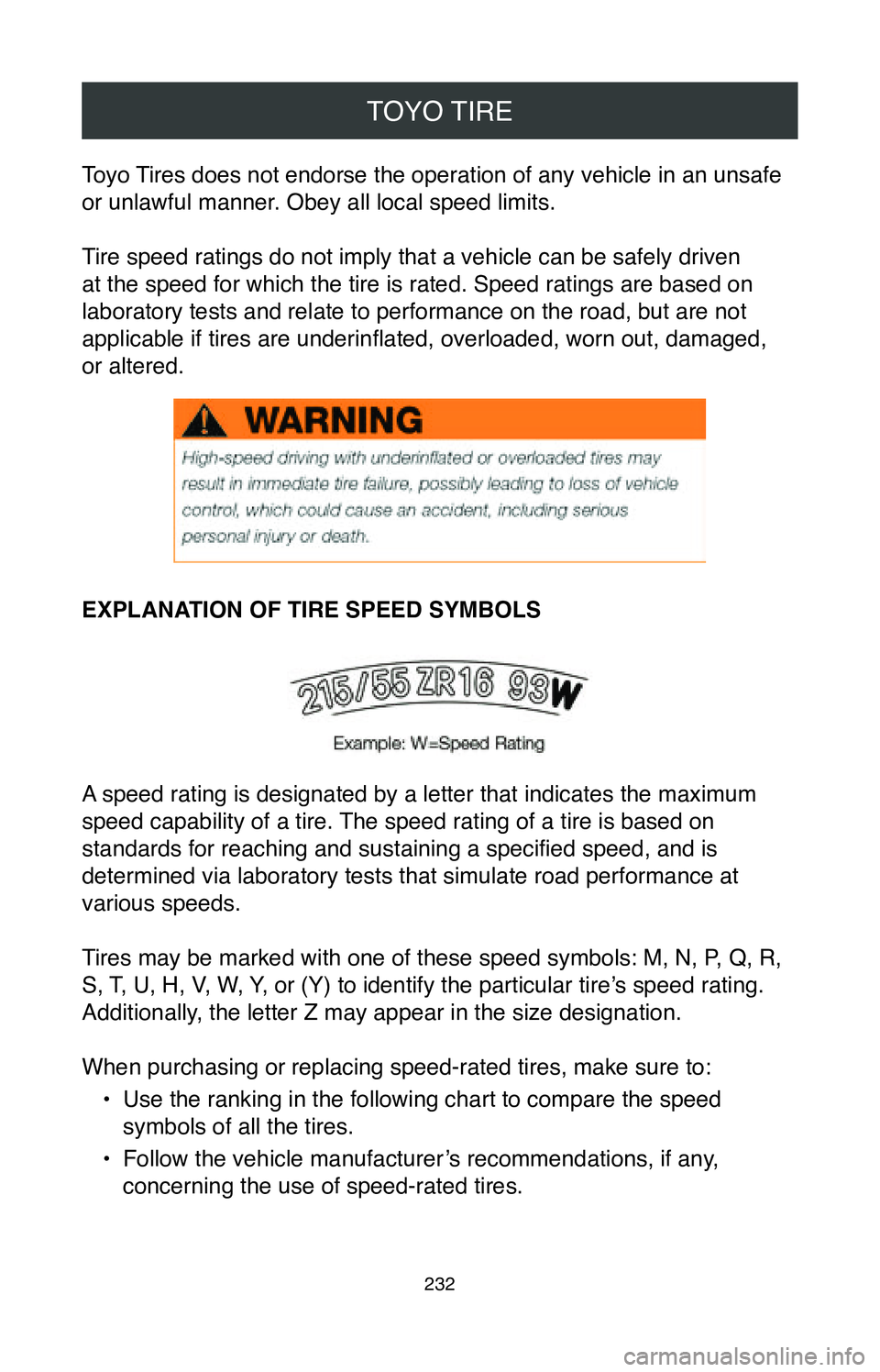
TOYO TIRE
232
Toyo Tires does not endorse the operation of any vehicle in an unsafe
or unlawful manner. Obey all local speed limits.
Tire speed ratings do not imply that a vehicle can be safely driven
at the speed for which the tire is rated. Speed ratings are based on
laboratory tests and relate to performance on the road, but are not
applicable if tires are underinflated, overloaded, worn out, damaged,
or altered.
EXPLANATION OF TIRE SPEED SYMBOLS
A speed rating is designated by a letter that indicates the maximum
speed capability of a tire. The speed rating of a tire is based on
standards for reaching and sustaining a specified speed, and is
determined via laboratory tests that simulate road performance at
various speeds.
Tires may be marked with one of these speed symbols: M, N, P, Q, R,
S, T, U, H, V, W, Y, or (Y) to identify the particular tire’s speed rating.
Additionally, the letter Z may appear in the size designation.
When purchasing or replacing speed-rated tires, make sure to:
•
Use the ranking in the following chart to compare the speed
symbols of all the tires.
•
Follow the vehicle manufacturer’s recommendations, if any,
concerning the use of speed-rated tires.
Page 235 of 260
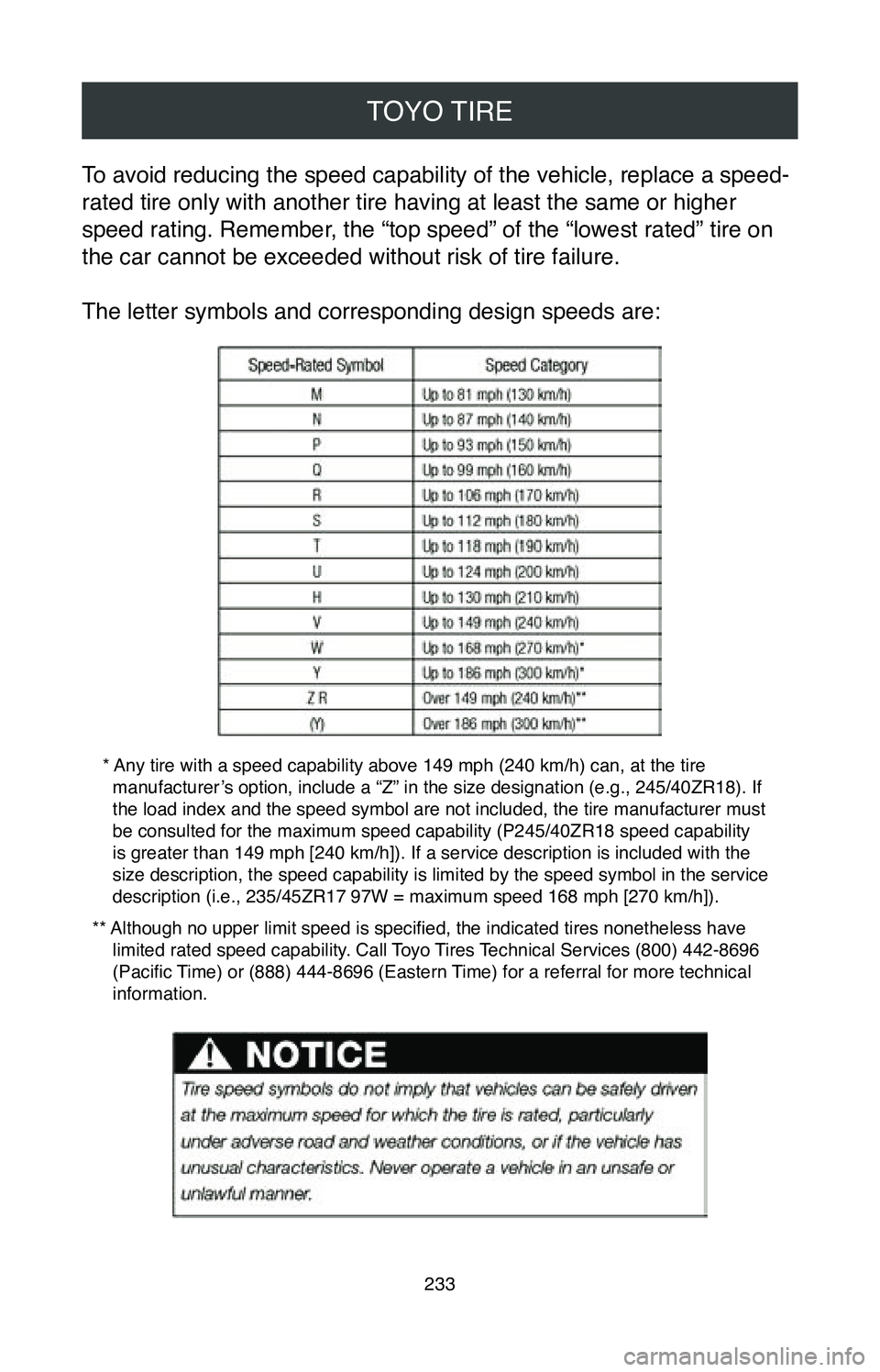
TOYO TIRE
233
To avoid reducing the speed capability of the vehicle, replace a speed-
rated tire only with another tire having at least the same or higher
speed rating. Remember, the “top speed” of the “lowest rated” tire on
the car cannot be exceeded without risk of tire failure.
The letter symbols and corresponding design speeds are:
* Any tire with a speed capability above 149 mph (240 km/h) can, at the tire manufacturer’s option, include a “Z” in the size designation (e.g., 245/40ZR18). If
the load index and the speed symbol are not included, the tire manufactu\
rer must
be consulted for the maximum speed capability (P245/40ZR18 speed capability
is greater than 149 mph [240 km/h]). If a service description is included with the
size description, the speed capability is limited by the speed symbol in\
the service
description (i.e., 235/45ZR17 97W = maximum speed 168 mph [270 km/h]).
** Although no upper limit speed is specified, the indicated tires nonetheless have limited rated speed capability. Call Toyo Tires Technical Services (800) 442-8696
(Pacific Time) or (888) 444-8696 (Eastern Time) for a referral for more technical
information.
Page 238 of 260
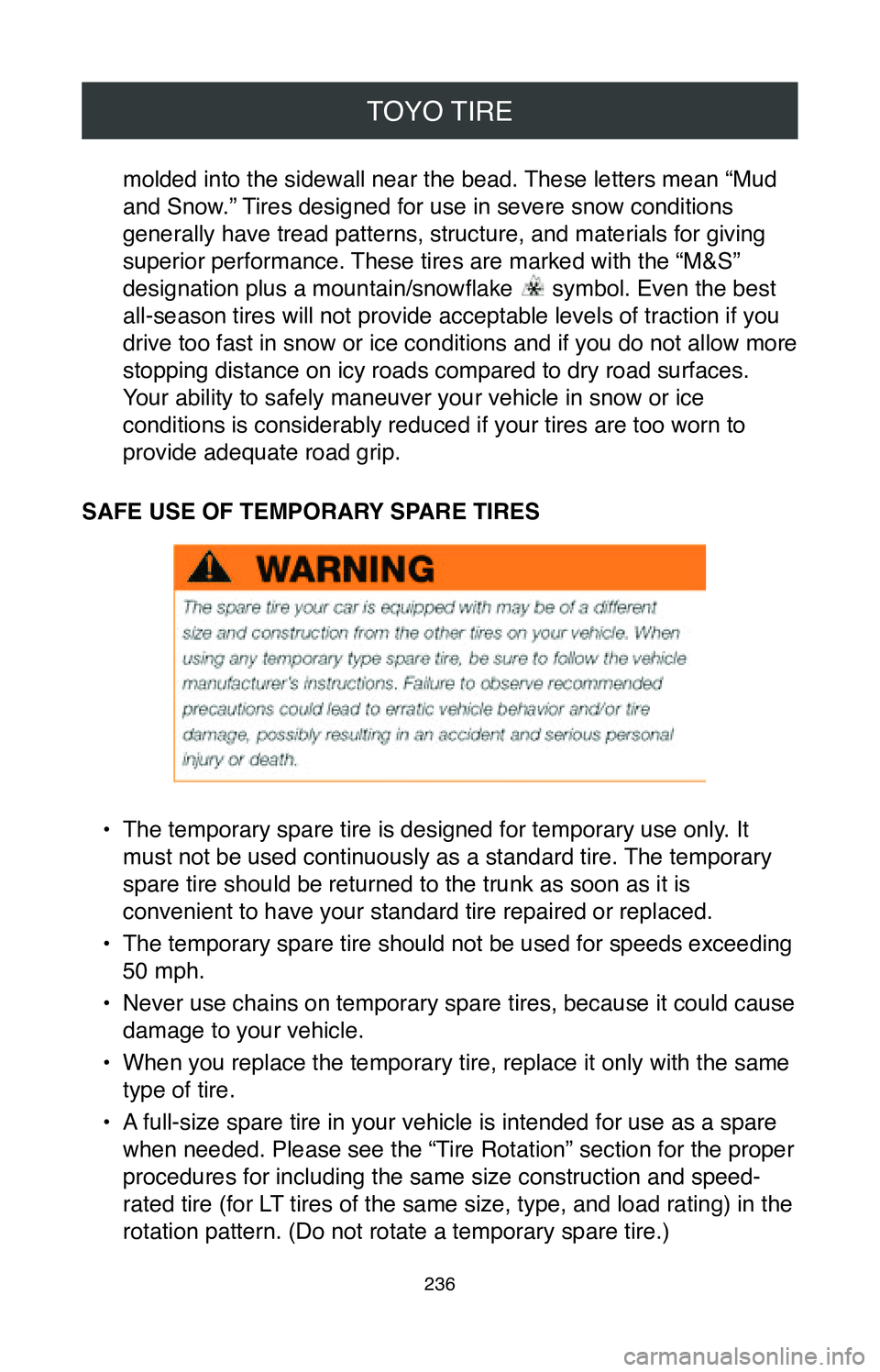
TOYO TIRE
236
molded into the sidewall near the bead. These letters mean “Mud
and Snow.” Tires designed for use in severe snow conditions
generally have tread patterns, structure, and materials for giving
superior performance. These tires are marked with the “M&S”
designation plus a mountain/snowflake
symbol. Even the best
all-season tires will not provide acceptable levels of traction if you
drive too fast in snow or ice conditions and if you do not allow more
stopping distance on icy roads compared to dry road surfaces.
Your ability to safely maneuver your vehicle in snow or ice
conditions is considerably reduced if your tires are too worn to
provide adequate road grip.
SAFE USE OF TEMPORARY SPARE TIRES
• The temporary spare tire is designed for temporary use only. It
must not be used continuously as a standard tire. The temporary
spare tire should be returned to the trunk as soon as it is
convenient to have your standard tire repaired or replaced.
•
The temporary spare tire should not be used for speeds exceeding
50 mph.
•
Never use chains on temporary spare tires, because it could cause
damage to your vehicle.
•
When you replace the temporary tire, replace it only with the same
type of tire.
•
A full-size spare tire in your vehicle is intended for use as a spare
when needed. Please see the “Tire Rotation” section for the proper
procedures for including the same size construction and speed-
rated tire (for LT tires of the same size, type, and load rating) in the
rotation pattern. (Do not rotate a temporary spare tire.)
Page 243 of 260
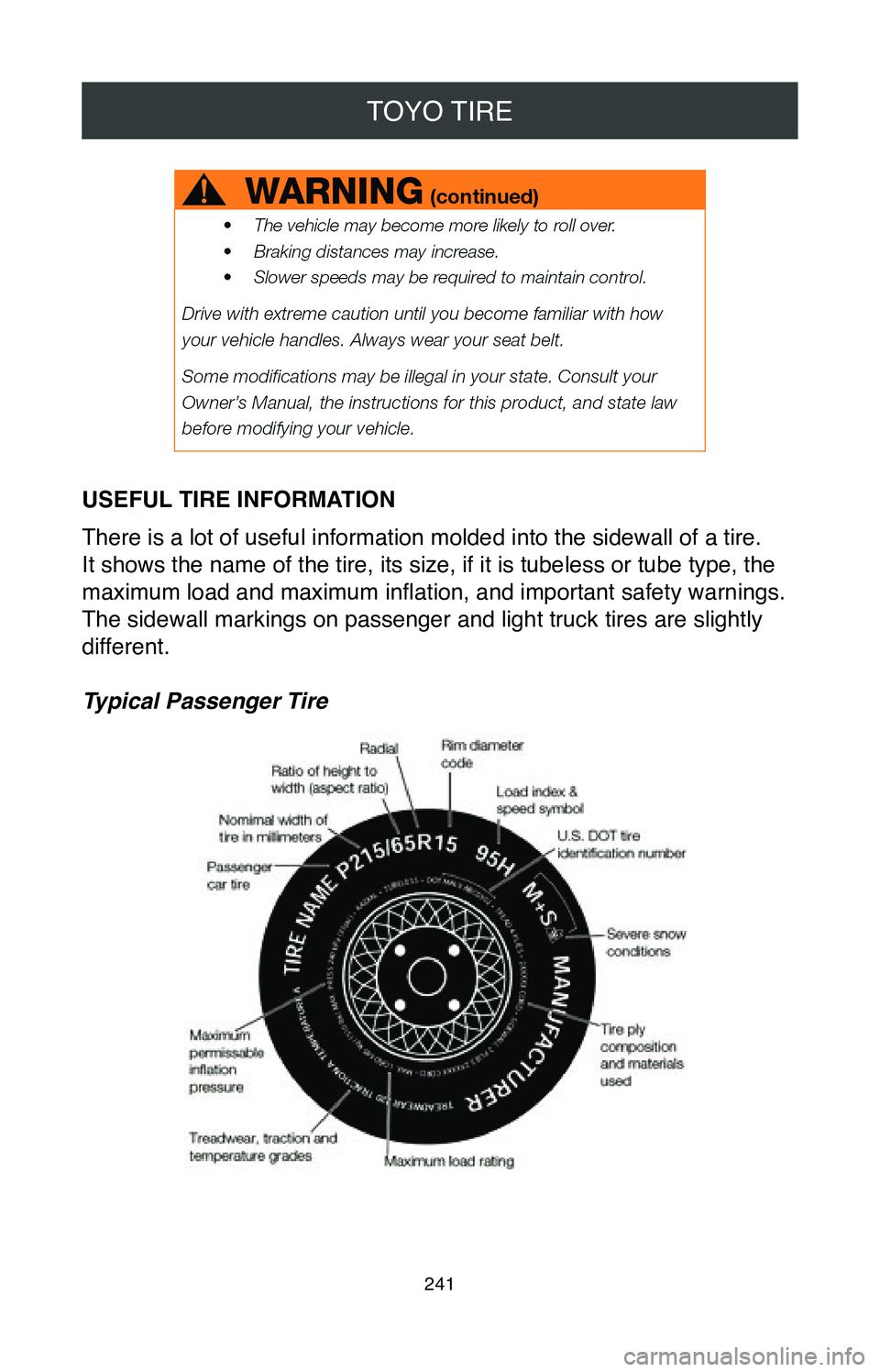
TOYO TIRE
241
USEFUL TIRE INFORMATION
There is a lot of useful information molded into the sidewall of a tire.\
It shows the name of the tire, its size, if it is tubeless or tube type,\
the
maximum load and maximum inflation, and important safety warnings.
The sidewall markings on passenger and light truck tires are slightly
different.
Typical Passenger Tire
Page 254 of 260
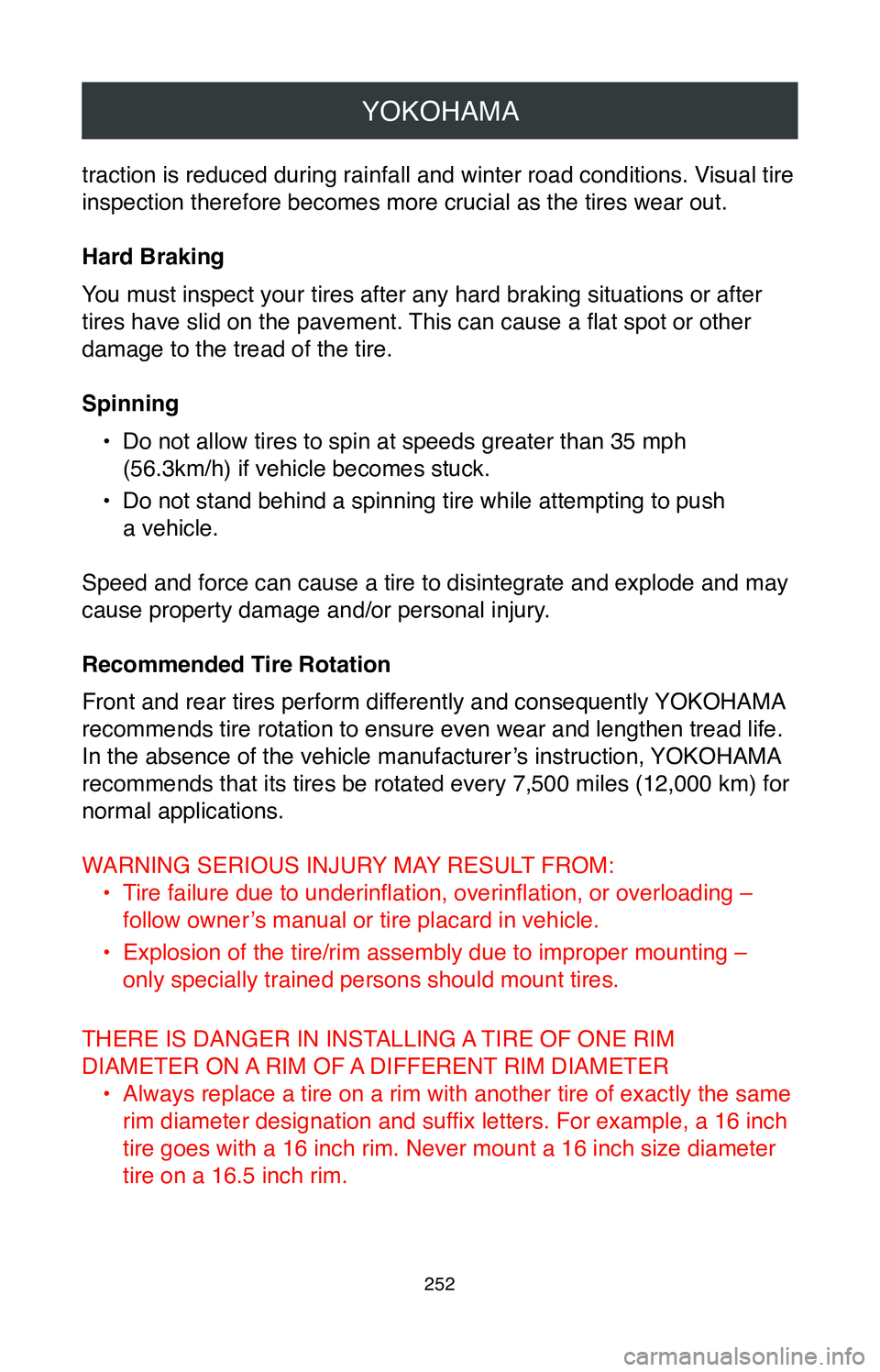
YOKOHAMA
252
traction is reduced during rainfall and winter road conditions. Visual tire
inspection therefore becomes more crucial as the tires wear out.
Hard Braking
You must inspect your tires after any hard braking situations or after
tires have slid on the pavement. This can cause a flat spot or other
damage to the tread of the tire.
Spinning•
Do not allow tires to spin at speeds greater than 35 mph
(56.3km/h) if vehicle becomes stuck.
•
Do not stand behind a spinning tire while attempting to push
a vehicle.
Speed and force can cause a tire to disintegrate and explode and may
cause property damage and/or personal injury.
Recommended Tire Rotation
Front and rear tires perform differently and consequently YOKOHAMA
recommends tire rotation to ensure even wear and lengthen tread life.
In the absence of the vehicle manufacturer’s instruction, YOKOHAMA
recommends that its tires be rotated every 7,500 miles (12,000 km) for
normal applications.
WARNING SERIOUS INJURY MAY RESULT FROM: •
Tire failure due to underinflation, overinflation, or overloading –
follow owner’s manual or tire placard in vehicle.
•
Explosion of the tire/rim assembly due to improper mounting –
only specially trained persons should mount tires.
THERE IS DANGER IN INSTALLING A TIRE OF ONE RIM
DIAMETER ON A RIM OF A DIFFERENT RIM DIAMETER •
Always replace a tire on a rim with another tire of exactly the same
rim diameter designation and suffix letters. For example, a 16 inch
tire goes with a 16 inch rim. Never mount a 16 inch size diameter
tire on a 16.5 inch rim.